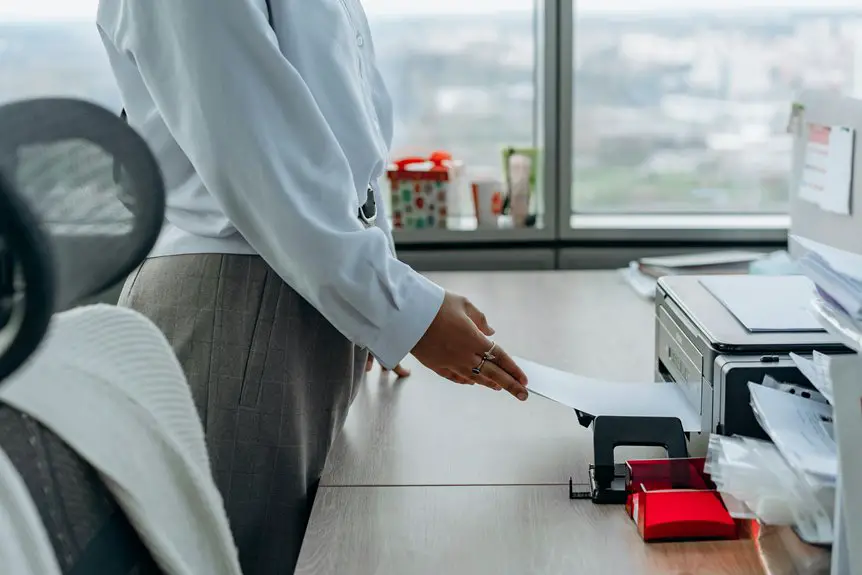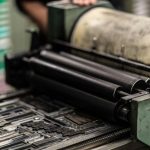When setting up your home office, choosing the right printer paper can make a significant difference in your output quality. You might think standard copy paper is enough for everyday tasks, but there are other options that can elevate your work. From glossy photo paper to textured presentation sheets, each type serves a unique purpose. So, how do you decide which paper best suits your needs? Let's explore the various types available and their ideal uses.
Table of Contents
Key Takeaways
- Standard copy paper is ideal for everyday printing tasks, balancing weight and cost for home office use.
- Photo paper enhances quality for printing images, with glossy options for vibrant colors and matte for a professional look.
- Presentation paper adds visual appeal with various finishes, suitable for professional documents and reports.
- Specialty paper offers unique textures and colors for invitations or creative projects, allowing for personalized touches.
- Consider eco-friendly paper options to reduce environmental impact while maintaining quality in your home office.
Understanding Printer Paper Basics
When it comes to printer paper, understanding the basics can make a big difference in your home office setup.
You'll want to consider weight, brightness, and texture when choosing the right paper. The weight, measured in grams per square meter (gsm), affects how your prints feel and look. Lighter paper's great for everyday printing, while heavier stock is ideal for presentations.
Brightness impacts how colors appear; the higher the brightness, the more vibrant your prints will be. Texture also plays a role—smooth paper works well for sharp text, while textured paper adds a touch of elegance for special documents.
Standard Copy Paper
Standard copy paper is an essential staple for any home office, providing a reliable option for everyday printing tasks.
Whether you're printing reports, invoices, or meeting notes, this paper type delivers consistent quality and performance. Typically weighing 20 lb, standard copy paper is lightweight yet sturdy enough for most printers and copiers.
You'll find it available in various brightness levels, with higher brightness offering sharper text and more vibrant colors.
When selecting copy paper, consider the size and compatibility with your printer; standard sizes include letter (8.5" x 11") and legal (8.5" x 14").
Stocking up on standard copy paper ensures you're always prepared for your printing needs without worrying about running out at crucial times.
Photo Paper
When it comes to printing photos at home, choosing the right photo paper is key.
Different types of photo paper offer various finishes and qualities, making them suitable for specific projects.
Let's explore the best uses and tips for getting the most out of your photo paper.
Types of Photo Paper
Choosing the right type of photo paper can make a significant difference in the quality of your prints.
There are several options available, each suited for different needs and preferences.
- Glossy Paper: This type offers vibrant colors and a shiny finish, perfect for photos that need to pop.
- Matte Paper: With a non-reflective surface, matte paper is great for portraits and artistic prints, allowing for a more subtle look.
- Satin Paper: This strikes a balance between glossy and matte, providing a soft sheen that enhances color without excessive reflection.
Best Uses and Tips
To get the most out of your photo paper, consider the specific purpose of your prints. Whether you're printing cherished memories or promotional materials, choosing the right type can make all the difference. For high-quality photos, use glossy or satin paper to enhance colors and details. If you're creating art prints, consider fine art paper for a textured finish.
Here's a quick guide to help you decide:
| Purpose | Best Paper Type |
|---|---|
| Family Photos | Glossy/Satin |
| Artwork | Fine Art Paper |
| Professional Prints | Matte/Heavyweight |
| Scrapbooking | Glossy/Photo Paper |
Presentation Paper
When it comes to making a strong impression, presentation paper is key.
You'll want to consider the various types, optimal weight and thickness, and the best printing techniques to achieve professional results.
Let's explore how these factors can elevate your presentations.
Types of Presentation Paper
Presentation paper comes in various types, each designed to enhance the visual appeal of your materials.
When you choose the right presentation paper, you're not just printing; you're making a statement. Here are a few types to consider:
- Glossy Paper: Ideal for vibrant images, it gives your prints a shiny finish that makes colors pop.
- Matte Paper: Offers a non-reflective surface, perfect for text-heavy presentations and a professional look.
- Textured Paper: Adds depth and character, making your documents feel unique and engaging.
Selecting the appropriate type can elevate your presentations, ensuring they leave a lasting impression.
Optimal Weight and Thickness
Choosing the right type of presentation paper is just the beginning; understanding its weight and thickness can make a significant difference in the overall quality of your prints.
For home office use, you'll want paper that strikes a balance between durability and presentation. Look for paper weights ranging from 200 to 300 gsm (grams per square meter) for a professional finish.
Thicker paper not only feels more substantial but also enhances color vibrancy and detail, making your presentations stand out. A thickness of around 10 to 14 mil is usually ideal, ensuring that your prints won't easily bend or tear.
Printing Techniques and Considerations
Understanding the right printing techniques can significantly enhance the quality of your presentation paper. To achieve professional results, you'll want to consider a few key factors:
- Printer Settings: Adjust your printer settings for high-quality output. Select the appropriate resolution and paper type to optimize ink distribution.
- Ink Quality: Use high-quality ink that's compatible with your printer. This ensures vibrant colors and sharp text, making your presentations stand out.
- Paper Handling: Handle your presentation paper carefully to avoid smudges and fingerprints. Store it in a cool, dry place to maintain its integrity.
Cardstock
Cardstock is a versatile paper type that can elevate your home office projects. Its thicker, sturdier composition makes it perfect for creating business cards, brochures, and flyers that stand out.
You'll appreciate its durability and professional appearance, especially when printing important documents or marketing materials.
When choosing cardstock, consider weight and finish; heavier weights offer more rigidity, while glossy or matte finishes can enhance visuals. Most inkjet and laser printers can handle cardstock, but check your printer specifications to avoid jams.
Cutting and crafting with cardstock are easy, allowing you to personalize projects like invitations or labels.
With the right cardstock on hand, you'll add a professional touch to your home office, impressing clients and colleagues alike.
Specialty Paper
If you're looking to add a unique flair to your projects, specialty paper is a fantastic option. It comes in various textures, colors, and finishes that can elevate your work beyond standard printing.
Whether you're crafting invitations, creating art prints, or designing unique reports, specialty paper can make a big impact.
Here are a few types to consider:
- Textured Paper: Adds depth and sophistication, perfect for invitations and announcements.
- Glossy Paper: Ideal for vibrant images and presentations, enhancing colors and details.
- Translucent Paper: Great for overlays and unique effects, giving your projects a creative twist.
Using specialty paper can truly set your work apart and impress your audience.
Don't hesitate to experiment with different types!
Recycled Paper Options
Recycled paper options are an eco-friendly choice that can suit a variety of home office needs. They're made from post-consumer waste, helping reduce landfill waste and conserving natural resources.
When you choose recycled paper, you not only support sustainable practices but also often find high-quality options that work well with your printer.
Look for 100% recycled paper for everyday printing or note-taking, as it performs just as well as standard paper. If you're printing important documents, consider recycled paper with a higher brightness for a professional look.
Plus, many brands offer recycled options that are compatible with inkjet and laser printers, ensuring you won't sacrifice print quality. Making this switch is a simple yet impactful way to go green in your home office.
Frequently Asked Questions
Can I Use Regular Paper for Photo Printing?
You can use regular paper for photo printing, but it won't deliver the best quality. For vibrant images, consider investing in photo paper, which enhances colors and sharpness, giving your prints a professional touch.
How Do I Store Unused Printer Paper?
To store unused printer paper, keep it in a cool, dry place. Avoid direct sunlight and humidity. Stack the reams flat to prevent warping, and use a protective cover for long-term storage.
What Is the Best Paper Weight for Everyday Printing?
For everyday printing, you'll want to use paper weighing around 20 to 24 pounds. This weight strikes a balance between durability and cost, ensuring your documents look professional without breaking the bank.
Are There Eco-Friendly Options for Glossy Paper?
Yes, you can find eco-friendly glossy paper options made from recycled materials or sustainably sourced fibers. Look for brands that emphasize sustainability and certifications to ensure you're making environmentally conscious choices for your printing needs.
How Often Should I Replace My Printer Paper?
You should replace your printer paper whenever you notice it running low or becoming damaged. Regularly checking supplies ensures smooth printing. Keeping a backup stock on hand helps you avoid interruptions during important tasks.




